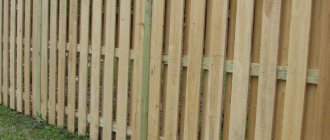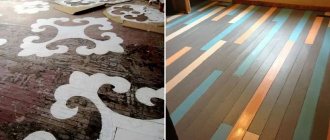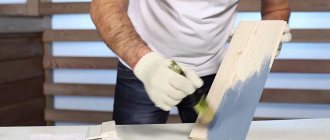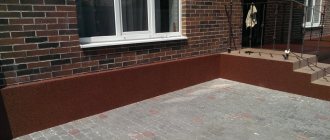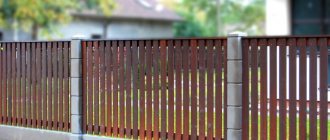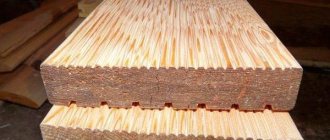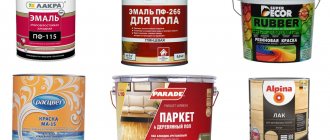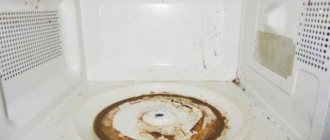Dye
These mixtures are very popular because they not only protect the material from moisture and sun, but can also give the product a certain color.
At the same time, modern manufacturing technologies make it possible to obtain a wide variety of shades, which is often used by designers. Therefore, if you are choosing an option on how to beautifully paint the outside of a wooden house, then you need to use several colors of dyes, combining them. The fact that some types of paints do not hide the structure of the wood deserves special attention. After processing, you can see the fibers and patterns. However, before making a decision, it is worth purchasing a sample and testing it on a small area.
What characteristics should you pay special attention to?
It's no secret that giving a building a beautiful and complete appearance is not the main function of façade paint. This coating must also have protective properties from external factors. Under the influence of negative external influences, particles of concrete, brick, etc. are washed out; wooden houses often begin to rot when there is excess moisture in the environment. You can often observe how, with high humidity, cracks form on the facades, leading to the destruction of the house.
As we found out, when choosing facade paint, you should start from what material it will interact with. Each paint has recommendations for use on a particular material, so choosing a paint is not such a difficult process.
When choosing facade paint, decorative, technical and technological characteristics should be taken into account. The first type of characteristics includes painting properties, level of paint consumption and its hiding power. Technological characteristics help determine the desired type of paint based on the material from which the wall is made. The decorative characteristics of facade paint are the ability to mix different colors to obtain the desired shade and the presence of light reflection properties. Performance characteristics also play an important role, protecting the coating from sudden temperature changes and sun rays, providing good moisture permeability and air conductivity. Performance characteristics are contained directly in the paint composition, which must be carefully studied before purchasing. It is impossible to unequivocally answer the question: what paint to choose for the facade? It all depends on the specific situation and the materials with which you will interact.
What paint can you paint a wooden house?
The question of which paint is best to paint the outside of a wooden house is far from idle. The choice of paint for the facade of a wooden house is a determining factor that determines how long the coating will last and how the wooden structure will look.
Paints for exterior painting must meet the following requirements:
- provide protection of wood from atmospheric agents;
- protect the structure from UV radiation;
- have a high level of moisture resistance;
- ensure color preservation for a long time.
There are several types of painting compositions that can be used to coat the external walls of a log house (including rounded logs), timber houses, and also to paint a frame house. To determine how to cover the outside of a timber house and understand what is better, impregnation or paint, to paint a wooden house so that it does not peel off and retains its original appearance for a long time, you need to get acquainted with the characteristics of each product.
Acrylic paints
- They have good resistance to atmospheric conditions.
- Protect wood from exposure to ultraviolet radiation.
- They create an elastic film on the surface that does not form cracks during wood shrinkage.
- They allow air to pass through and do not interfere with air exchange processes occurring in the wood.
- They dry very quickly, the specific time depends on the type and moisture content of the lumber.
- They form a durable coating that retains its original color and does not lose its aesthetic characteristics for 8-10 years.
Acrylic paints are quite expensive. Instead, you can use inexpensive acrylate dyes for a log house, which have similar characteristics. The difference between them is that in the first case the composition contains only concentrated compounds without any impurities. In the second, additives are used: acrylate-copolymer dispersions, which reduce the cost of paint.
Oil based paints
- They are distinguished by a very high degree of resistance to precipitation.
- Provide reliable protection of wood from moisture penetration.
- They have excellent penetrating ability and are perfectly absorbed by wood.
- They form a beautiful glossy finish that will last about six years.
The only drawback that oil-based façade paint for a wooden house has is that it takes quite a long time to dry. The drying speed of this paint is about a day.
Antiseptic impregnations
Antiseptic compositions are divided into:
- Glazing. They form a transparent coating that preserves and enhances the beauty of natural wood.
- Toning. The wood is painted in the chosen color, while completely preserving the natural relief of the wood.
Varnishes, waxes and stains
- Wax is absorbed very well into wood and protects it from moisture and dirt. After waxing, the surface of the imitation timber will acquire a beautiful matte shine.
- Stain protects the surface from fungus and various pests, but this product alone is clearly not enough, such a coating will be short-lived. How to treat the outside of the lining after applying the stain? It is best to apply varnish on top, which will enhance the protective properties and extend the service life of the coating.
- Clear or colored varnishes are great for painting a house made of laminated veneer lumber. In both cases, the natural relief of natural wood will remain visible; colored varnish will only change its shade.
Types of paint
Based on their composition, paints are divided into oil and acrylic paints, alkyd enamels, and antiseptics. Let's study the characteristics of each option.
Oily
It is inexpensive, absorbs well into wood and creates a reliable coating that is resistant to weathering. Minus - it is not suitable for painting the sunny side of a building, since under the influence of UV rays it quickly fades, fades and loses its attractiveness. The service life is short - about 6 years.
Acrylic
Creates a coating that is resistant to precipitation and ultraviolet radiation. The elastic film that forms after the coating dries does not crack and is vapor permeable, that is, it does not disturb the environmentally friendly microclimate of a wooden building. The service life of acrylic coating is at least 10 years.
In European countries, acrylic paint is the preferred choice for wooden facades. More than 80% of wooden houses in Europe are painted with these types of paints.
Alkyd enamel
When dry, enamel compounds create a film impenetrable to moisture, but they dry too quickly, without having time to properly absorb into the structure of the wood. For this reason, the enamel coating is not durable.
It is recommended to use enamel to paint areas most exposed to moisture - window and door openings, thresholds.
Another advantage of alkyd paints is their high frost resistance. The coating can withstand temperatures below -30°C - an important indicator for regions with harsh winters.
Antiseptics
The compositions last 10-12 years, penetrate wood fibers to a depth of 7 mm and protect walls from all types of influence, preventing rot and the spread of fungus. Antiseptics are either coating or translucent. In the first case, you can choose what color to paint the wood; in the second, the composition preserves and favorably emphasizes the natural texture of the wood.
How and with what to paint the outside of an old wooden house
Refresh the paint on an old house and make it look like new
Where to start painting a house
Like all repair work, you need to start with calculating the material. You need to measure the area of the part of the house that is to be painted. It should correspond to the area of the walls minus the area of existing windows and doors.
Then calculate the required amount of paint for this. This is quite easy to do. All cans always indicate the average paint consumption per square meter, which should be multiplied by the area of the measured wall of the house. What happened is multiplied by two, since to obtain a good quality coating you should apply at least two layers of paint.
How to paint the outside of an old wooden house
What paint to buy and what color to paint the house? For painting an old wooden house, oil paint or alkyd enamel is best. It is still preferable to purchase alkyd enamel; although it is more expensive than oil paint, it has a longer service life of the paint layer, up to six years, while oil paint has up to three years.
As for the color scheme for painting your house, then as they say, “there are no friends according to taste and color.” You can paint a wooden house any color you like. You can paint the outside of the house either one color or combine two or more colors.
Paint an old house any color you like
How to paint a house correctly - let's get to work!
The first stage is preparatory, perhaps the dirtiest and not very pleasant, but necessary. When preparing the surface of the walls before painting, you need to check and replace, if necessary, fragments of the old cladding that have become unusable.
Then, using a metal brush, carefully remove the old paint and clean the walls from peeling and dust. Window frames and trim, as well as doorways, should be sanded. Then construction tape and wrapping paper (or, alternatively, old newspapers) will come in handy, with which you can protect the window glass from paint getting on it.
How to renovate an old house - let's start painting
Before painting the house, it would be a good idea to treat the surface with a primer; the paint will lie smoother, and the consumption will be less. After you have thoroughly mixed the paint in the jar, you should immediately apply it to the surface of the wall, moving from top to bottom, using a wide brush. This is done in order to rub the flowing paint, preventing the formation of drips.
When applying the first layer, it is advisable to use paint of a thinner consistency, which penetrates faster and fills minor damage and cracks. After just a couple of days, the surface of the walls can be repainted.
And the final touch is to tidy up and update the cornices, door and window frames. These parts need to be painted with a narrow hair brush, having previously cleaned them of dirt and dust. It is better to choose paint in lighter tones than the main color, or even in a contrasting color. When finished, remove paper and tape from the windows.
How and with what to paint the outside of an old wooden house
How and with what to paint the outside of a wooden house to give the building a completely new look - read our article
Facade painting technology
How to paint the outside of a wooden house? A question that arises when moving on to decorating the exterior of a home.
Exterior painting of a wooden house is carried out both on a newly built house and on an old structure that has a coating. Why do dyes age and how to slow down this process?
Firstly, absolutely all materials are subject to the aging process. The tree is no exception. Proper care of wood by humans can extend the life of the material. Exposure to external factors accelerates the aging process, so it is the human task to ensure reliable protection of wood.
Wood also deteriorates from pests and mold. From their influence, wood loses its strength and reliability, even if it is new.
Humidity also negatively affects wood, causing it to swell and dry out. These processes ultimately lead to the formation of fungus inside the material.
Immediately before painting the facade, preparation for painting is carried out.
Professional painting of wooden houses is impossible without proper preliminary preparation of the facade for painting work.
First of all, it is necessary to clean the work surface from dust and other debris, fungus, and mold. An effective product from the famous brand “Tikkurila” will help you cope with mold and mildew. After cleaning, the surface is primed and the resin is removed from the wood.
Cleaning a wooden house of old paint is an important step in the technology of painting the outside of a wooden house, which should not be neglected if you want to get a good result of your work. Removing old coating is a painstaking process that takes a lot of personal time.
How to remove old paint from a wooden house? To do this, you can use a stiff brush, spatula, grinder, sandpaper, Karcher, etc. It all depends on the type of old coating and on the availability of one or another available tool.
After cleaning the working surface, you can proceed to priming and treating it with an antiseptic. When performing priming work, it is necessary to carefully treat the facade from below. after all, this is where the surface is exposed to moisture. A primer with an antiseptic reliably protects against the formation of fungus, mold and rot of the material.
Coating wood with façade paint can only be done after the primer has completely dried. This process may take several days. What color to paint a wooden house on the outside is impossible to answer this question, since everyone is guided by their own preferences and tastes.
types of paints for painting a wooden facadeKnowledge of the pros and cons of each type of paint will help you choose the right coating for the facade. By understanding the features of each type of paintwork before purchasing, you can avoid wasting money on facade painting material that is not suitable for you.
Material calculation
Before purchasing paints and varnishes, you need to calculate the required amount of product. For ease of understanding, an example of a calculation is given based on varnishing prepared parquet.
For a room with a floor area of 15 square meters, therefore, you will need
- water-based varnish 15 x (100…120) = 1500…1800 g or
- alkyd varnish 15 x 80 = 1200 g.
Calculations will be greatly simplified using special calculators.
The amount of primer, stain, impregnation and other things is calculated in the same way
When making calculations, it is important to reserve at least 10% for unforeseen circumstances or possible problems with some of the materials
Reasons for the need to stain wood
Why is it generally necessary to treat wood with various paints and varnishes? It would seem that the natural texture of wood is attractive in itself, and in most cases there is no particular need to embellish it? And all this is due to the fact that impregnation and painting of wood is capable of preserving its physical and aesthetic properties for the longest possible time, such as integrity, strength, warmth, environmental friendliness of the material and the beauty of its textured pattern.
As you know, the first enemy of wood is moisture, which, when it penetrates the structure of the material, has a destructive effect on its fibers. As a result, they swell and deform, losing elasticity and strength. Inside a house with damp walls, various fumes that are unpleasant for the senses inevitably dominate, which easily permeate the structure of the wood. In addition, dampness always “kicks off” the biological decomposition of wood, causing the appearance of mold and blue stains, which, in turn, in addition to creating an unhealthy atmosphere in the premises, also weaken the strength of the building material.
Paint and varnish products, as well as special protective compounds, are primarily designed to protect wood from negative external influences and preserve its structure from destruction. And, of course, the task is always to preserve the aesthetic texture of the wood unchanged or to decorate it in accordance with the intended interior design.
Requirements for paint and varnish materials for wooden facades
All paint and varnish materials can be divided into two large types: for interior and exterior work. External painting of a wooden house will help protect it from negative influences. Therefore, increased demands are placed on exterior paints. After all, operating conditions inside and outside are significantly different. The main requirement for compositions for interior work is odorlessness, environmental friendliness and abrasion resistance. Interior painting of a wooden house is faster and easier.
Requirements for compositions applied to the façade surface:
- High rates of adhesion and adhesion to the surface.
- Improved characteristics of resistance to minor damage, impacts, scratches, chips. High wear resistance.
- Weather resistance. The environment and bad weather should not affect the appearance of the facade and the quality of the paint. This includes chemical inertness to acids and alkalis.
- High levels of protection against moisture. Wood is afraid of it, so façade paint for wood should provide reliable protection to the coating.
- Resistance to temperature changes.
- They are not afraid of the influence of ultraviolet rays.
- High levels of vapor permeability, so that painting the external walls of a wooden house does not interfere with the wood’s ability to breathe.
- Be flexible even after drying. Wood tends to expand and contract under the influence of temperature changes. Therefore, the paint layer should not crack. This is achieved by the elasticity of the composition. Rubber paint on wood for exterior use has high indicators of this parameter.
- Easy to care for. Frequent washing should not be a problem.
- Resistant to fading, maintaining the original color for a maximum period of time.
If the composition meets most of the requirements, then painting wooden surfaces will be as effective as possible.
How to choose the best paint for the facade
This question does not arise every day, but only in cases where it is necessary to refresh the appearance of the house or when decorating the appearance of a built house. In order to ensure a long-term, impeccable appearance of your home, before starting work, you need to devote some time to studying the types of facade paints and the features of working with them. Only if there is a harmonious combination of the quality of the consumables and the qualifications of those who work with them is it possible to achieve the expected result.
Upon completion of the construction of a residential building, a person is faced with the need to think over the appearance of the building. As a rule, the main emphasis is on the beautiful aesthetic appearance of the house, and the issue of determining the color of the facade is one of the decisive ones.
When choosing paint for the facade, you should be guided not only by the aesthetic side, because the coating for the street part of the building must meet other requirements:
- eliminating paint conflict with the base of the building;
- protection from water/moisture;
- have good vapor permeability;
- be resistant to dust and other contaminants;
- high resistance to sunlight;
- be durable and elastic;
- be resistant to biological pests.
Facade paints that contain alkalis can react actively with the base, resulting in a conflict of materials, which can lead to the destruction of the wall.
The choice of façade paint depends entirely on the material serving as the base of the wall. When purchasing paint, you should read the composition and recommendations for painting a particular substrate.
Solvents
Typically, paints are sold ready-to-use and do not require additional components. However, to save money, some craftsmen prefer to dilute the mixture with a solvent to apply the first layer. You can also use this substance when working with materials that are too thick or to remove dye from hands or clothing.
Having chosen how to paint the outside of an old wooden house, you should immediately purchase a solvent of the appropriate type. Typically, information about what type of this substance is needed is indicated on the coated packaging. However, they do not have to be from the same manufacturer.
Painting wood while maintaining texture
A pronounced wood pattern can be achieved using glaze, pigmented oil or wax. These compounds apply quite tightly, almost painting over the structure of the wood fibers. Any of the compositions described above can be applied with a brush or roller.
When applying paintwork materials, take very little, first applying them in fragments along the entire length of the lining. Then, using a brush or roller, the applied strokes are shaded over the entire surface. After leaving them to soak for 5-10 minutes, to reveal the texture, take a soft, lint-free cloth and remove most of the oil. As a result, the pattern appears much brighter than in its original state: a larger amount of pigmented product is retained in the grooves, and almost none remains on the protruding parts. The result is a pronounced texture. This technique is also called brushing or texturing the lining. In interiors, wood processed in this way looks very decorative: both on the walls and on the ceiling.
The process can be observed in the video. Three samples were painted: two with the same oil with pigment, one with colorless. 5 minutes after painting, one of the pigmented blanks is wiped to reveal the design. To preserve the wood after the pigment has dried (24 hours or more, read on the packaging), the lining is coated with two layers of colorless oil (glaze, wax). In areas of intensive use, you can also coat it with matte varnish.
Technology
The whole process takes place in 4 stages
At the same time, scrupulousness and attention are required to complete the work.
It is important to do everything carefully, without leaving untreated areas.
Stage 1. Removing the old coating. This procedure is performed if there is an old paint coating. It needs to be removed. To do this, you can use spatulas, a wire brush, sandpaper or a grinder with an attachment. There will be quite a lot of dust, so you should work with glasses and a respirator.
All work is carried out in dry, not hot weather. The entire area of the facade will have to be protected, including the joints of logs or boards. In order for the work to be completed efficiently and without delay, remove the drainage elements, shutters and trim from the facade in advance. In addition to old paint, dust and street dirt should be removed from the facade.
Stage 2. After the facade is cleared of paint, the wood is sanded and puttied. If there are areas of darkening, or pockets of fungal infection are visible, the top layer of material should be removed to a clean texture. The rest of the surface is leveled. Existing defects on the surface are eliminated by puttying. Before moving on to the next steps, the putty must dry. The putty material must be compatible in composition with impregnation and paint.
Stage 3. Deep penetration impregnation is applied to the cleaned wooden surface, the composition of which is selected depending on the characteristics that require strengthening. Typically, impregnation is applied with a wide brush along the grain to preserve and emphasize the natural texture of the wood.
Do not neglect priming; impregnation will not only improve the quality of the wood, but will increase the adhesion of paint to the surface, while reducing the amount of material consumed. Even though wood primers are quite expensive, their use is worthwhile. Before applying the paint, the impregnation must dry; the period for complete drying is indicated by the manufacturer on the packaging.
Step 4. Before starting work, check the long-term weather forecast. Rain is not suitable for painting, nor is heat. In addition, work should be carried out during the daytime, when the dew has either already evaporated or has not yet settled, that is, from 10 to 18 hours. The paint is applied in several layers along the fibers. Each subsequent layer should be applied only after the previous one has dried.
Some nuances of coloring
It would seem that the process is quite simple and transparent. But here, as everywhere else, there are nuances:
- If the facade has external metal fastening elements, then before priming and painting they should be filled with an oil or acrylic compound to match the color of the wood. This work will be especially relevant if the finishing coating is planned to be made transparent.
- If you approach the issue carefully, you can use several impregnating compounds; water-repellent impregnation is applied last.
- For better surface quality, after the impregnation has dried, the wood should be sanded to remove small roughness and lint.
Sequence of painting work
To properly paint a wooden house, you need to follow the technology and sequence of actions. Painting a frame house follows the same rules as a log house.
- First of all, the surface is cleaned of dust, construction debris, and resin stains - otherwise, mixed with the paint, foreign particles will remain on the facade. If this is not the first treatment of the building, then carefully remove the previous paint and clean the surface down to wood.
- Then mechanical grinding of the surface is carried out manually or using a grinding machine. Sanding and further painting are carried out with a short break, no more than 3 days, so that the cleaned base does not have time to suffer from external factors.
- In an old house, cracks, unevenness and damaged areas are puttied. If nails or other metal elements protrude from wood, they are coated with a special primer designed for metal.
- After this, the entire surface is covered with a primer with antiseptic properties and impregnations. The primer will not only perform protective functions - after its application, paint consumption will noticeably decrease and it will apply more evenly.
- Then they move directly to painting. The paint is applied with a roller or sprayed with a spray gun. It is necessary to take into account that acrylic facade paints and varnishes are too thick and viscous - only a professional tool is suitable for them. To use household sprayers, the paint will have to be thinned, which means the layer will be thinner than the manufacturers recommend.
- Painting is done in several layers. Each subsequent layer is applied only after the previous one has completely dried. When painting with a roller or brush, apply the paint along the grain of the wood.
Exterior painting of a wooden house
Let's move on to practice and answer the question of how to properly paint a wooden house with your own hands.
An important point is the calculation of paint and varnish consumption. The manufacturer indicates the basic quantity on the containers and in the accompanying instructions, but the type of facade also matters. Thus, houses made of timber will require more paint than frame structures, approximately 50-100 g/sq.m. m. In addition, painting can be single- or multi-layer. To save money, use a spray gun instead of a brush and rollers.
The quality and service life of the coating depends on the preliminary preparation of the surface. Unfortunately, this stage is not always given due attention. But even the best paints and varnishes will last longer if the boards and logs are thoroughly cleaned of dust, protruding stains of resin and other foreign substances.
Attention. A new house built from timber, which the manufacturer has already treated with an antiseptic, primer and fire-resistant compounds, does not require preliminary preparation.
So, the main stages of painting:
- Cleaning the surface from dust, dirt, mold.
- Primer of metal elements - nails, screws, etc. This will protect the metal from corrosion.
- Drying. Clean surfaces must be thoroughly dry. In the rain, the walls are covered with waterproof film.
- Wood primer. Apply a layer of antiseptic, paying the greatest attention to the ends of the boards and logs.
- Finish coating. For reliability, it is advisable to apply the paint in 2-3 layers.
Advice!
It is recommended to do the final painting in the morning or evening - during periods of minimal solar activity. This will allow the coating to dry evenly and absorb better.
How to paint the outside of an old wooden house using old paint
There is only one recommendation - if the old layer holds well and is not covered with cracks and there are no areas of film peeling visible on it, then you need to use the type of paint that was used previously. You can confidently apply alkyd paint over oil paint - they combine well. But acrylic ones are not suitable here, although some manufacturers allow such contact.
If you do not know what type of paint was previously used to paint the house, it can be determined by the appearance of the old coating. If the old coating has a leathery surface and is slightly chalked, then most likely the house was previously painted with acrylic paint. Acrylic paint cracks along the grain of the wood.
If you can roll a small piece of paint into a tube, then most likely you are dealing with acrylic paint. If a piece of paint cracks when rolled up, it is most likely oil paint. Oil paint develops net cracking as it wears.
If the surface is covered with a glossy film of glazing antiseptic, then the surface can be repainted with the same antiseptic or with oil or alkyd paint. To repaint with acrylic paint, you will need to remove all the old antiseptic film down to the wood.
What paint is best to paint the outside of a wooden house?
To determine the best way to paint a wooden house, you need to get acquainted with the dyes that are suitable for painting the external walls of old wooden buildings.
There are several types of coloring compounds:
- Oil paints have very good penetrating ability and are perfectly absorbed by wood. They are also highly resistant to any weather conditions.
- Acrylate paints form an elastic coating on the surface that does not crack when wood shrinks during seasonal temperature fluctuations. The house will need to be repainted no earlier than ten years after the renovation.
- Coating antiseptics reliably protect wood from various adverse weather conditions, and also prevent the formation of mold and rot.
Types of paints used
Oily
They win mainly only in price. Although there are a number of advantages. Drying oil-based paints penetrate deeply into the structure of the material and are resistant to changes in external atmospheric conditions.
They also differ in the specific application. The fact is that the drying time for oil paints (depending on the outside temperature) is several hours. And if you consider that the air always contains particles of dust, then you also need to “guess” calm weather. Otherwise, as often happens, some places will have to be touched up.
Acrylate
These have all the necessary qualities that are needed specifically for wood.
- Firstly, they do not create an airtight layer, so after their application the log or board continues to “breathe”.
- Secondly, even hardened paint has some elasticity. Therefore, as the “wood” deforms, the layer of such paint and varnish coating will not crack.
- Thirdly, they retain their appearance for 7–8 years, and this is exactly the approximate period when cosmetic repairs of any structure are carried out.
Covering antiseptic
Such compositions have an alkyd-acrylate base.
There is a relatively new type of such product on the market of paints and varnishes. With their help, you can give a respectable look to even low-grade wood, which allows you to use cheaper materials in construction. Such compositions “last” for more than 10 years. It should be understood that any paint will completely hide the wood texture. Painting is usually done if the house is finished with a simple smooth planed board. But if the walls are built from expensive material (calibrated logs, laminated veneer lumber, etc.), then there is no point in using paint. Otherwise, the money spent on the material (wood) will literally be “thrown away.”
For such blanks it is advisable to use colorless varnishes and azures. The surface will become glossy, which will only add to the attractiveness of the house. The use of colored varnishes will not affect the wood grain in any way, but will slightly change the shade of the surface.
Based on cost, paints are divided into:
- economy class (budget) formulations, the cost of which is no more than 100 rubles/kg. These include “Texturol”, “Aquatex”, “Senezh” and a number of others;
- Tikkurila, Belinka - compositions of average cost (within 200 - 300 rubles / kg);
- “Premium” – 350 rubles/kg and above. For example, Johnestones, Dulux, Woodworks.
Useful tips
When painting a new house for the first time, the choice of paint and varnish is at the discretion of the owner. But if staining is repeated, it is recommended to use the same composition that was used previously. That is, apply “oil” to oil paint, and “acrylic” to acrylic paint. Craftsmen say that the latter can also be laid on top of oil ones with preliminary surface treatment.
To determine the type of old paint and varnish composition, it is enough to make a small cut of it. If the “sample” breaks easily, then it was oil paint. The acrylate layer easily rolls up into a “roll”.
It is not recommended to paint wooden surfaces if they are exposed to sunlight. This will lead to uneven drying of individual areas, and as a result, “stains” on the wall.
When choosing a paint composition from a little-known manufacturer, it is worth asking what year this particular type of paint has been produced? It’s somewhat strange when newfangled products are guaranteed to have a 15-year “service life,” although their production was launched only 2–3 years ago. Therefore, this has not been confirmed by practice.
Do not forget that no paint will increase the service life of wood if it has not been pre-treated with antiseptics and fire retardants, and the surface has not been primed.
When choosing a specific composition, you need to pay attention to its resistance to ultraviolet radiation, as well as the approximate consumption (per 1 m2). It varies between paints
Therefore, it’s not only about the price for 1 can, but also about their required quantity.
Top 5 manufacturers of facade paints: review of the best coatings 2018
The modern building materials market offers a huge selection of facade paints to suit every taste and budget, so people don’t know which paint to choose and which manufacturer to trust.
So, most often we use façade paints from the following top manufacturers:
・Marshall
is a popular paint (manufactured in Turkey), the quality of which makes the brand one of the best on the modern market. Since 1953, it has been one of the best-selling brands in Europe. All products have excellent adhesion and good physical properties, are fade resistant and easy to clean. In addition, giving preference to the paint of this manufacturer, consumers note the economical consumption of the coating;
・finncolor
is a leader in the production of high-quality products for home design and decoration. Founded in 1862, the company is the most experienced and successful on the market. The brand's products are resistant to temperature changes and also have a high degree of protection against biological pests (mold, mildew, etc.);
・empils
- a product of domestic production, operating since 1897. Since the beginning of the 20th century. The company began to actively develop in the direction of chemical production, focusing on the production of high-quality paints. One of the best manufacturers of wall paints on the domestic market;
・alpina
is a leading German manufacturer of paint and varnish coatings for walls on European and international trading platforms. The paints of this manufacturer are recognized as the most environmentally friendly and cleanest possible. Also, German-made products are highly resistant to dirt and UV radiation;
・dufa is another German manufacturer, one of the leaders among manufacturers of paint and varnish coatings used in repairs and construction. The company is positioned as a manufacturer of environmentally friendly painting materials and European quality products.
Enamels
This material deserves special attention, since in some countries it is not isolated separately, but is sold as paint. However, the differences are quite large, which makes it possible to expand the scope of such substances.
The fact is that enamels create very durable surface films that can withstand even serious mechanical stress. In this case, the coating is perfectly smooth and, in most cases, glossy. Therefore, craftsmen, when advising how to paint the outside of a wooden house, often lean towards this particular material, especially if the surface has certain defects or putty areas.

